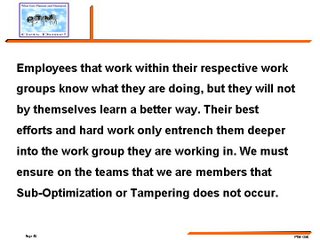I received an interesting Email that I would like to share:
“I have been assigned to find a company that specializes in Continuous Process Improvement (Kaizen). There are thousands of hits off the Search Engines. I was intrigued by your blog because you don’t advertise all those silly ads and you seem to say (question) it straight and at the same time saying you are not an expert. Can you “please” recommend a company I can contact?
- Desperate in Atlanta

A) Before and after the Internet explosion I had the responsibility of traveling the United States attending many Quality Forums, Seminars, Baldrige Visits,Trainings, etc by Quality professionals (at least 20 or more) all promising one way or another that their product and services was the answer to my company’s needs and requirements.
I found some promising (we eventually settled on one now bought out by another vendor which I do not support) but most were nothing more than charlatans hiding behind some buzz words and articles that others had written in the American Society for Control (now ASQ) Magazine.
The Internet has increased the number of Charlatans advertising by 10 fold and now blogs have added another ten fold of Houdini quality wannabees. Personally as I stated before I don’t care if folks advertise on their sites but it is strange they would promote someone else selling the same stuff they are trying to sell (that should be your first warning) on their blogs. They get paid for folks hitting those sights by Google.
Don’t let any Internet site convince you they have the solutions or answers to your problems (second warning). Watch out for ones that criticize others with no basis or facts other than what they think they know (third warning). Remember, the Internet is information, not knowledge. I call it the “Global Billboard.”
Do your homework, create a list of questions, visit the company or request they visit you, agree to nothing over the phone or any form of E-mail or Web communicating other than getting information. Continue to ask questions and more questions that pertain to your situation, if you get wide variation of answers from Manufacturing to Service to … that they do it all hang up immediately (fourth warning). If you become more interested ask for a list of clients and contacts, DO NOT let them send you to one or to recommend whom to call. If they do not supply a complete list, say good bye (fifth warning). If the Quality improvement consultants does not have enough resources (they will say yes and hire people after they secure your contract) to handle a company of your size, sayonara (sixth warning). Ask for a history of the company you want to do business with, how many times have they changed their names to join on the quality band wagon (Q – Circles to Lean Sigma, seventh warning) Last warning, if the company you are dealing with does not have employees trained by one of the Quality Masters (i.e. Deming) or one of their “appointed” followers keep searching. Just make sure they are not self proclaiming themselves.
You would be amazed by the answers or no answers I get to questions from Blog sites that proclaim self-imposed expertise. I am no expert, just one person seeking Profound Knowledge by asking continual questions that has traveled the Q shaped road for many years... I hope the couple of leads I sent will help. Good Luck




